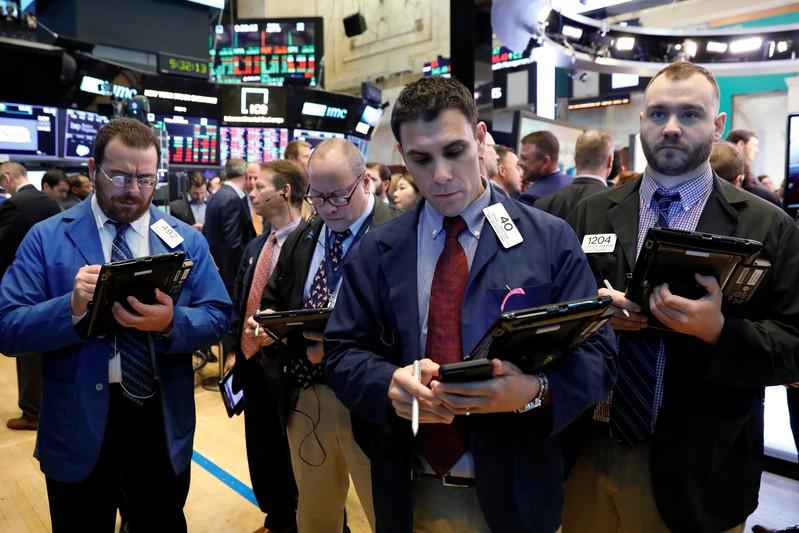
LONDON (Reuters) - Following are five big themes likely to dominate thinking of investors and traders in the coming week and the Reuters stories related to them.
1/FED UP AGAIN
Federal Reserve policymakers meet on May 2-3 after raising rates in March and signalling at least two more 25 basis point increases were in the offing this year. Some economists expect three.
The Fed is unlikely to raise rates this time around, with moves considered likely only at the June, September and December meetings, which are followed by press conferences.
But inflation worries and rising federal borrowing have helped lift U.S. 10-year yields above 3 percent for the first time in over four years, while two-year notes are yielding 2.50 pct, a level last seen during the 2008 crisis.
Fed tightening could lift two-year yields to, say, 2.75 percent by year-end, especially if it hikes more aggressively than markets expect.
You could argue that locking up money at that rate for two years is a lower-risk commitment than more volatile equity investments. The S&P 500 is 7 pct below January's record high and average dividend yields are under 2 percent.
2/IT'S ALL ABOUT THE DATA
A softening in European economic data has been one of this year's market surprises. It has put greater significance on upcoming releases as investors assess the implications for central bank policy.
Markets have already scaled-back expectations of when the ECB will deliver its first interest rate hike of this economic cycle, while a May rate rise from the Bank of England looks increasingly unlikely after Friday's data showing the British economy virtually ground to a halt in Q1.
Flash euro zone Q1 GDP on Wednesday and April inflation numbers on Thursday, together with a raft of European corporate earnings, are likely to underscore a slowdown from brisk expansion last year.
ECB chief Mario Draghi acknowledged this week that growth has moderated. If next week's data confirms that, the ECB will have all the more reason not to rush stimulus withdrawal, which means bond yields and the euro could drop.
3/THREE IS THE MAGIC NUMBER
Asia's trade-deficit economies are going through a rough period, vulnerable to oil prices at 3-1/2 year highs. Indonesia's central bank governor said he would be prepared to adjust interest rates, just two days after admitting to heavy intervention to defend the rupiah.
Like the Philippine peso and Indian rupee, the rupiah has lost around 5 pct of its value from January's highs and analysts reckon interest rates could rise sooner than previously expected in these three countries.
Oil prices show little sign of coming off amid concerns over renewed U.S. sanctions on Iran.
PMI surveys and inflation data next week will give investors a picture of the domestic economies, and whether they are strong enough to cope with higher U.S. yields and the possibility that oil prices rise even further from current levels of around $75 a barrel.
4/BETWEEN A DOLLAR AND A HIGH YIELD
It's been a bruising week for emerging markets, which are being roiled by the simultaneous rise of the dollar and U.S. 10-year bond yields -- the latter above 3 percent for the first time in over four years. The question is, can the sector, beloved by investors for the past 18 months, withstand the pressure?
South Africa's rand, Russia's rouble and Argentina's peso have weakened around 2 percent against the dollar this week. Many others are not far behind.
Dollar borrowing costs for emerging sovereigns have blown out to multi-month highs and investors have pulled $5.6 billion from emerging debt and equity funds since mid-April, according to the Institute of International Finance.
Stronger-than-expected Q1 U.S. growth has set the stage for next week's Fed meeting. Investors will closely watch the intersection of Treasury yields and the dollar to see how much more pain may lie ahead for emerging markets.
5/STAPLES SQUEEZED
As bond yields rise on expectations of higher interest rates, one thing that comes into focus is the equity risk premium (ERP) -- the price paid to investors to compensate for the risk of investing in stocks rather than bonds.
It was this issue that was core to February's global equity selloff -- the sudden realisation by investors that government bonds could soon provide a viable safer alternative to equities.
Typically, first in line to be bruised by higher yields are consumer staples, which are known as "bond proxies" due to generous dividends and comfortable cash flows. So when U.S. 10-year yields rose above 3 percent this week, concerned clients called analysts asking what this meant for consumer staples stocks.
Indeed, higher yields have already caused an adjustment in the price-earnings ratios of firms such as Nestle and Unilever. And $100 million flowed out of consumer stocks and utilities -- another bond-proxy sector -- this week, EPFR figures showed.
But higher yields are not the only challenge: more salient might be the disruptive effect of internet shopping, and companies' waning pricing power in a more inflationary environment.
(This story corrects date of Federal Reserve meeting to May 1-2)
(Reporting by Alden Bentley in New York, Marius Zaharia in Hong Kong, and Julien Ponthus, Helen Reid, Dhara Ranasinghe and Karin Strohecker in London; Compiled by Sujata Rao; Editing by Catherine Evans)
This story has not been edited by Firstpost staff and is generated by auto-feed.
Updated Date: Apr 28, 2018 01:08 AM